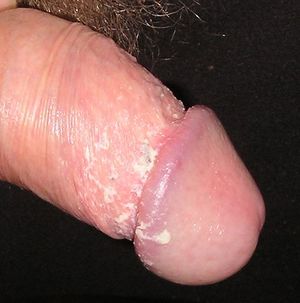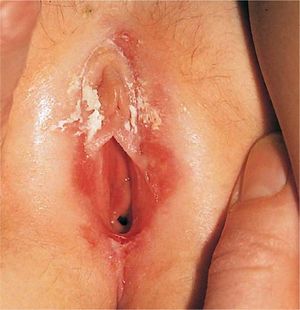Smegma


Smegma is the name given to a flaky material that accumulates underneath the foreskin in males, and underneath the clitoral hood and within the labial folds in females. In males, it is composed of secretions of ectopic sebaceous glands in the foreskin, mixed with secretions of the prostate, seminal vesicles, mucin from the urethral glands, and desquamated epithelial cells.[1] [2] Smegma is not dirt or "filth". It is natural, normal, benign, painless, harmless, and beneficial.[3] Smegma is not an irritant and does not cause itching. It may remain in the preputial sac for extended periods without doing harm. Its presence is not considered esthetic, so it is customary to wash it away prior to a sexual encounter.
Intact adult males who wash their penis and glans periodically with clean water usually do not have smegma between the inner foreskin and glans. In infants and boys whose foreskin cannot yet be pulled back (natural phimosis), smegma doesn't matter, while the foreskin protects the glans. The illustration "Smegma on a human penis" is therefore not typical for intact men who wash their genitals regularly. Hardened smegma accumulations may be softened by soaking with vegetable oil.
Excessive washing and the use of soap inside the foreskin should be avoided, because soap removes the skin oil so it can cause non-specific dermatitis that may be mistaken for balanitis.[4]
Contents
Beneficial aspects of smegma
Smegma contains natural skin oils that are beneficial to the health of the mucosa that covers the glans penis and the preputial sac. The oil also has lubricating advantages.[5]
Smegma is usually washed away for cosmetic reasons. Excessive washing and use of soap inside the foreskin should be avoided.[4]
Smegma was falsely claimed to be carcinogenic
Circumcision promoters of the past who alleged a relationship between "lack of circumcision" and genital cancers formerly implicated smegma or smegma-borne pathogens as the causative agent. Only two histologic studies of human smegma have ever been conducted, both of which found it to be perfectly harmless.
The hypothesis that human male smegma is carcinogenic was first formulated in 1932 by circumcision promoter Abraham L. Wolbarst, M.D.[a 1][6] Wolbarst also believed that circumcision prevented epilepsy. (In the early part of the 20th Century, the paroxysm of masturbation in children was often misidentified as an epileptic seizure.) He wrote: "[Circumcision] diminishes the tendency to masturbation, convulsions and other reflex phenomena of local irritation."
No laboratory or clinical research had been done on the subject at the time. Regardless, Wolbarst's hypothesis about smegma and cancer found its way into early medical textbooks. In the 1950s a few experiments were done to test the hypothesis by injecting horse smegma into wounds made in the backs of mice. There were clinical studies that attempted to induce cancer by introducing smegma subcutaneously and intravaginally: No carcinomas could be induced.
The smegma hypothesis was finally disproven by an exhaustive study by Reddy in 1963.[7] His results were: "The conviction that human smegma is a carcinogen could not be substantiated."
Van Howe & Hodges (2006) concluded: "The purpose of the scientific method is to distinguish between wishful thinking, strongly held opinion, and provable fact. The smegma theory of disease, which began as wishful thinking on the part of circumcision zealots such as Abraham Wolbarst and Abraham Ravich, has evolved into irrefutable dogma, but as modern physicians, we need to recognize that, until proved otherwise, smegma is harmless."[3]
Control of smegma
Boys are born with a non-retractable foreskin. The foreskin of a boy should not be retracted until it spontaneously becomes retractable with increasing maturity and the boy retracts it for himself.[8] There is likely to be a collection of smegma in the preputial sac that has been accumulating harmlessly since birth. The smegma may then be washed away. Some boys will have hardened smegma that is difficult to remove. Soaking the hardened smegma with olive oil is said to be effective in softening it and facilitating its removal.
Parkash (1972) reported that the flow of urine in the preputial sac can keep it free of smegma.[9]
The smegma may be washed away using warm water when necessary. Soap, body wash, and shampoo remove the natural oil so they should not be used in the preputial sac.[4]
Video
Smegma, what is it and how to deal with it
Dr Bret Palmer describes the formation of smegma.
Dr O'Donovan explains the nature of smegma
Foreskin: Why Pull Back?
Dr Bret Palmer explains why the foreskin should be retracted. This is for adult males and NOT applicable to boys.
How to get rid of a build up of hard smegma, the easy way
Dr Bret Palmer gives tips on getting rid of hardened smegma.
See also
- Cervical cancer
- Immunological and protective function of the foreskin
- Penile cancer
- Penis
- Preputial sac
External links
 Cara, Ed (21 May 2015).
Cara, Ed (21 May 2015). Just What Is Smegma And Why Does It Make Us Cringe?
, Medical Daily. Retrieved 19 November 2022.
Smegma 101
, Your Whole Body. Retrieved 20 June 2020. Hill, George (9 November 2008).
Hill, George (9 November 2008). The “foreskin causes cancer” myth
, Wordpress, genitalwholeness. Retrieved 6 December 2020.
Quote:Circumcision alters human behavior. Many males who originate in circumcising cultures, and who are likely to be circumcised, have special emotional issues. Circumcised doctors, therefore, tend to behave differently from normal doctors. Those who become doctors may use junk science to promote male circumcision. The myth of cancer protection by circumcision continues to be a favourite claim of such doctors.
 Smith, Lori (6 January 2018).
Smith, Lori (6 January 2018). How do you clean out smegma?
, MedicalNewsToday. Retrieved 19 January 2021. Rangel, Frank (17 July 2023).
Rangel, Frank (17 July 2023). Smegma: What Is It and How to Get Rid of It
, Foreskin. Retrieved 11 December 2024.
NSFW
 Erickson, John.
Erickson, John. Smegma
, http://www.foreskin.org. Retrieved 29 August 2022. Anonymous (1 October 2025).
Anonymous (1 October 2025). Is it normal to be getting smegma daily?
, REDDIT. Retrieved 14 October 2025.
Abbreviations
- ↑

Doctor of Medicine
, Wikipedia. Retrieved 14 June 2021. In the United Kingdom, Ireland and some Commonwealth countries, the abbreviation MD is common.
References
- ↑
 Parkash S, et al. Sub-Preputial Wetness - Its Nature. Ann Nat Med Sci (India). 1982; 18(3): 109-112. Retrieved 16 October 2019.
Parkash S, et al. Sub-Preputial Wetness - Its Nature. Ann Nat Med Sci (India). 1982; 18(3): 109-112. Retrieved 16 October 2019.
- ↑
 Hyman AB, Brownstein MH. Tyson's
Hyman AB, Brownstein MH. Tyson's Glands
. Archives of Dermatology. January 1969; 99(1): 31-37. Retrieved 16 October 2019. - ↑ a b
 Van Howe RS, Hodges FM. The carcinogenicity of smegma: debunking a myth. J Eur Acad Dermatol Venereol. 2006; 20(9): 1046. DOI. Retrieved 16 October 2019.
Van Howe RS, Hodges FM. The carcinogenicity of smegma: debunking a myth. J Eur Acad Dermatol Venereol. 2006; 20(9): 1046. DOI. Retrieved 16 October 2019.
- ↑ a b c
 Birley HDL, Walker MM, Luzzi GA, Bell R. [https://www.ncbi.nlm.nih.gov/pmc/articles/PMC1195128/ Clinical Features and management of recurrent
balanitis; association with atopy and genital
washing]. Genitourin Med. October 1993; 69(5): 400-3. PMID. PMC. DOI. Retrieved 28 February 2020.
Birley HDL, Walker MM, Luzzi GA, Bell R. [https://www.ncbi.nlm.nih.gov/pmc/articles/PMC1195128/ Clinical Features and management of recurrent
balanitis; association with atopy and genital
washing]. Genitourin Med. October 1993; 69(5): 400-3. PMID. PMC. DOI. Retrieved 28 February 2020.
- ↑
 Wright J. How smegma serves the penis. Sexology. September 1970; 37(2): 50-3. Retrieved 21 June 2020.
Wright J. How smegma serves the penis. Sexology. September 1970; 37(2): 50-3. Retrieved 21 June 2020.
- ↑
 Wolbarst AL. Circumcision and penile cancer. Lancet. 16 January 1932; 1(5655): 150-3. DOI. Retrieved 13 March 2022.
Wolbarst AL. Circumcision and penile cancer. Lancet. 16 January 1932; 1(5655): 150-3. DOI. Retrieved 13 March 2022.
- ↑
 Reddy DG, Baruah IK. Carcinogenic action of human smegma. Archives of Pathology. April 1963; 75(4): 414-420. Retrieved 16 October 2019.
Reddy DG, Baruah IK. Carcinogenic action of human smegma. Archives of Pathology. April 1963; 75(4): 414-420. Retrieved 16 October 2019.
- ↑
 Wright JE. Further to the "Further Fate of the Foreskin". Med J Aust. 7 February 1994; 160: 134-135. PMID. Retrieved 4 September 2025.
Wright JE. Further to the "Further Fate of the Foreskin". Med J Aust. 7 February 1994; 160: 134-135. PMID. Retrieved 4 September 2025.
- ↑
 Parkash S. Phimosis and Its Plastic Correction. J Indian Med Assoc. 16 May 1972; 58(10): 389-90. PMID. Retrieved 24 July 2025.
Parkash S. Phimosis and Its Plastic Correction. J Indian Med Assoc. 16 May 1972; 58(10): 389-90. PMID. Retrieved 24 July 2025.
